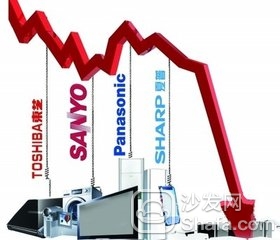
The front line of Japanese TV companies in the global market has shrunk again. This has added a room for imagination to the domestic brands that are poised to go to sea. Then, will domestic color TV manufacturers enter the gilt era in overseas markets? Can Japanese TV manufacturers make a comeback?
Japanese companies shrink their overseas front
Since 2015, for the sake of improving the financial situation or the overall development strategy, Toshiba, Panasonic, Sharp and other Japanese TV companies have successively thrown out color TV business plans for overseas markets.
According to reports, Toshiba will completely withdraw from TV production, stop its TV business operations in overseas markets, and will only develop and sell domestically. Production will be performed by Chinese companies, and Toshiba is already searching for "in-laws" for color TV plants in Indonesia and Egypt.
Following the closure of the Shanghai Color TV Factory in 2013, Panasonic announced in early February that it had shut down its color TV manufacturing facility in Shandong and started the company's clearing procedures. Panasonic said that it will not withdraw from the Chinese market and will continue to sell ultra-thin smart TVs under the Matsushita Electric brand in China. In addition, Panasonic also considers selling TV sets in Mexico.
According to Japanese media reports, Sharp, another Japanese home appliance manufacturer, is considering selling its color TV plant in Mexico and considering giving up its color TV business in North America, but may license its brand in the North American market to other companies.
Domestic brands benefit from geometry?
Regarding the contraction measures taken by Japanese color TV brands in overseas markets, some domestic media and industry professionals believe that China's color TV companies will usher in an opportunity. Beijing Business Daily wrote in the article: "With Toshiba, Panasonic, Sharp and other Japanese color TV giants have announced or sold or closed overseas factories, a market vacuum of nearly 36 million units has been reserved for color TV companies such as China and South Korea."
In fact, for domestic color TV companies that have encountered growth bottlenecks in the domestic market, overweight exports have become a consensus. According to Ove Cloud Network data, the total volume of China's color TV market in 2014 was 44.61 million units, a year-on-year decrease of 6.6%; sales were 146.2 billion yuan, a year-on-year decrease of 14.5%.
Although the domestic color TV companies experienced a growth dilemma in the domestic sales market, they have been advancing rapidly in overseas markets. According to statistics from the General Administration of Customs, China’s total color TV sets were exported to 74.50 million units in 2014, a year-on-year increase of 24.3%, and the export volume was 13.55 billion US dollars, an increase of 22.6%.
However, related media and industry sources also pointed out that domestic brands also face considerable difficulties in overseas markets, and the biggest pressure comes from Korean companies.
According to Li Yaqin, deputy general manager of Quzhi Consulting, the competitive environment of domestic brands in overseas markets in 2015 will not be as good as in 2014. Except for some growth in the North American market, other markets will be worse than in 2014. Quzhi Consulting estimated that global color TV shipments in 2015 will reach 223 million units, an increase of 3.7% year-on-year, and the growth rate will slow down significantly from 2014.
On the other hand, Korean brands have adopted more aggressive strategies in overseas markets, such as Samsung, whose shipment target for 2015 is 60 million units, an increase of 11 million units compared to 2014; LG’s 2015 shipment target is 38 million. Taiwan, an increase of 6 million units over the previous year.
“Chinese brands will face changes in the competitive environment and pressure in overseas markets and need to make some strategic adjustments,†said Li Yaqin.
Can the Japanese Legion make a comeback?
Japanese-color TV brands underwent a new round of strategic contraction in overseas markets, leading some industry players to sway the Japanese color TV industry again. These declining aristocrats, but also restore the glory of the past it?
Li Yaqin believes that Japanese TV companies are unlikely to make a comeback in the global market. In her view, Japanese brands do not have manufacturing advantages, high production costs, and slow response to the market. The aforementioned factors, as well as the price shocks of Chinese and South Korean color TV manufacturers, have led to a long-term loss of some color TV companies in Japan, such as Sony, whose color TV business has suffered losses for as long as 10 years.
In addition to its lack of manufacturing advantages, the fierce market competition has made the color TV industry's profits thinner and thinner. It has also accelerated the shift of the Japanese company's business focus, gradually divested the color TV business and shifted to more profitable emerging businesses.
According to reports from the Japanese media, Matsushita’s operating profit was 290 billion yen in the first three quarters of fiscal 2014 (April-December 2014), a year-on-year increase of 10%. The largest contribution to growth was in automotive lithium batteries and solar panels. product. Toshiba will focus on semiconductors, infrastructure and health care in the future.
Based on this, Li Yaqin judged that in 2015, Japanese TV companies will continue to have a shrinking strategy in terms of scale and share, but will focus on high-end markets.
In overseas markets, the shrinking of Japanese brands has determined that it has become a supporting role for the market, while Korean brands and Chinese brands have sang the protagonist, and the competition in the global market will become more intense.
Recommended installation sofa butler, download address: http://app.shafa.com/

Hot Apps Recommended: HDP VST All-in-one Fast-viewing film Dragons Live Karaoke King TV Thumb Playing ZAKER